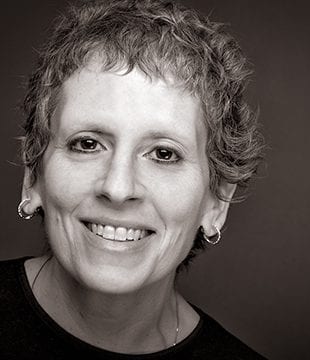Animation as the Highest Art Form
 For Judy Kriger, Associate Professor and Co-Chair of Animation, it all started with the famous animator Chuck Jones, best known for his work with Warner Bros. Cartoons on the Looney Tunes and Merrie Melodies shorts.
For Judy Kriger, Associate Professor and Co-Chair of Animation, it all started with the famous animator Chuck Jones, best known for his work with Warner Bros. Cartoons on the Looney Tunes and Merrie Melodies shorts.
Jones, of course, begat Bugs, Daffy, Porky, Wile E., the Road Runner and so many others in Warner Bros.’ wild and hilarious brood. “I have fond memories of watching those animated shorts with my parents and siblings,” she recalls. “And I always enjoyed drawing.”
She followed her passion for drawing, obtaining a BFA from Rhode Island School of Design and an MFA from CalArts. Currently teaching Intro to 3D Animation Production and the Senior Studio classes, Professor Kriger’s regard for Animation as a discipline is expansive. “In my view, animation is the highest art form because it combines all of the arts,” she says. “You have to cultivate the rhythmic grace of a dancer, the artistic talents of a painter or sculptor, the eye of a cinematographer, and the timing and stage presence of an actor.”
Professor Kriger is as passionate about teaching as she is about the discipline itself. “I tell my students to learn to love learning,” she says. “This field entails being open to constantly embracing new things, working well with others and communicating stories clearly. Animation requires being motivated to work hard and dedicating time for lots of “pencil mileage.” While it’s essential to stay current with the latest software, ultimately, it’s not about the tools – it’s about being a creative person who can think on his or her feet, and being open to feedback while simultaneously being able to maintain your integrity in an ever-changing field.”
In a career that has taken her from the pre-digital era at Rhode Island School of Design to State University of New York and Santa Monica College, from Comedy Central, DreamWorks and Nickelodeon to Chapman University and now Woodbury, Professor Kriger has been witness to something of revolution in animation.
“The field is constantly changing,” she says. “I shot my hand-drawn undergrad animation on 16mm film, using a professional animation camera stand called the Oxberry. As a grad student, however, I quickly realized that I was going to have to learn digital tools or I’d be left behind. Being adaptable to change is probably the most important quality anyone in the field of animation should have.”
That reverence for adaptability set the stage for her book, Animated Realism (Focal Press, 2012), which she describes as an exploration of the animated documentary genre. “At CalArts, we were required to create an animated film in any medium we desired,” she says. “I hand-animated a charcoal-on-paper film about immigration, which was based, in part, on interviews I did of my grandparents and other immigrants I met while traveling.” It’s subject matter about which she’s still passionate and that may evolve into a new animated project.
“I’m a serious Pixar addict,” Prof. Kriger admits. “I’ve also developed a love for independent animation — people who are outside the studio system — and artists who use animation in non-traditional ways, such as in animated docs,” singling out Drawn From Memory and Waltz With Bashir. “The Man Who Planted Trees, one of my absolute favorite films, shows how we can each pay it forward and make the world a better place,” she says.
Professor Kriger couldn’t be more bullish on the job market for Animation grads. “It’s a great time for students,” she says. “There are now more platforms than ever and much more need for content than there has been in many years. Places like Netflix and Amazon Prime are in search of original ideas. In addition to animation and VFX studios, there’s also need for animated content in medical and legal settings, game and app development and architectural renderings. For animators, the sky’s the limit!”